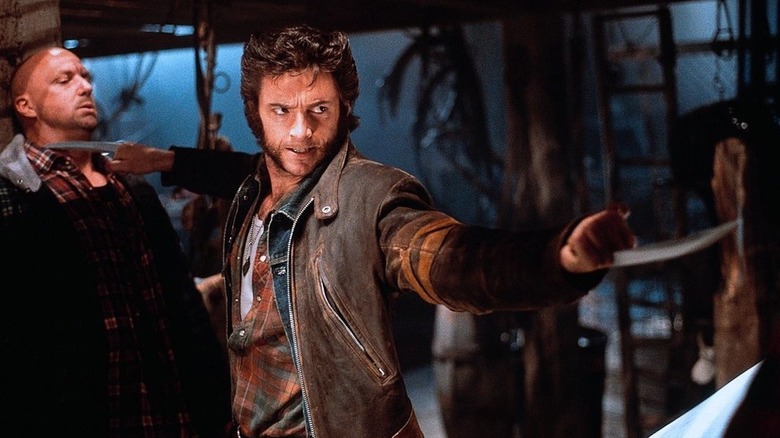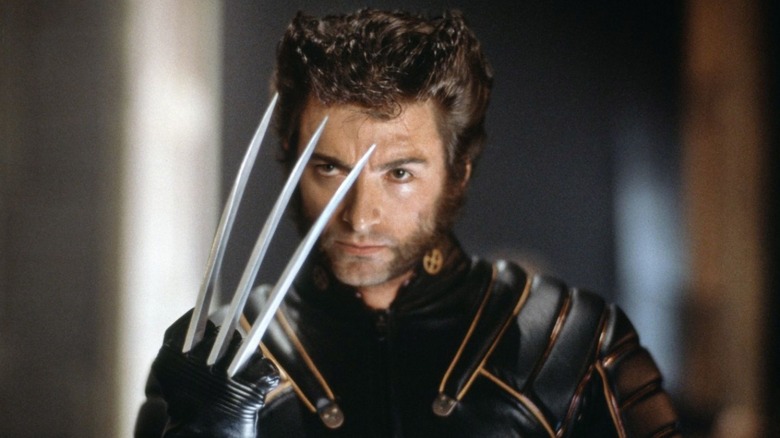Kevin Feige Had A Surprising Hand In Crafting Hugh Jackman's Wolverine
In a world currently dominated by superhero movies, it's sometimes difficult to think back to a time when making one of these films was anything but a sure bet. DC characters such as Batman and Superman had movies that were bonafide hits, though by the time the late '90s rolled around, the former had crashed and burned with 1997's still reviled "Batman and Robin," and the latter hadn't been seen in a movie since the disastrous "Superman IV: The Quest for Peace." There had been some attempts at movies centering on Marvel characters, but the only one to really find success was "Blade" in 1998. So when 20th Century Fox released "X-Men," the film landscape was drastically different than it is today.
When "X-Men" hit theaters in 2000, it was an exciting moment for comic fans, who weren't used to seeing their heroes portrayed on the big screen. Director Bryan Singer famously did not want comics influencing the film, going so far as to ban them from the set. He was concerned they would interfere with the three-dimensional characters he was trying to create — which sounds like someone who hasn't really read any comics at all. There was a hesitance to fully embrace the source material, a feeling that audiences were not yet ready for Wolverine's yellow spandex, which was used as a punchline in the movie.
In fact, Hugh Jackman, the man now so synonymous with Wolverine that he seems impossible to recast for the Marvel Cinematic Universe, was not a popular choice at the time. The actor came on later in production, replacing Dougray Scott, who, by the way, is also too tall and handsome to play Wolverine. However, Jackman embodied the character better than anyone could've imagined, proving that him having almost a foot on his comic book counterpart made exactly zero difference. Despite the fact that some fans vehemently want these live-action adaptations to look exactly like the comics they know and love, Jackman proved early on how little that actually matters.
Singer may have wanted Jackman to go in blind, but there was a rebel on set who insisted the actor familiarize himself with Wolvie's best stories. How else was he supposed to be the best there is at what he does? One person giving Jackman forbidden reading material was none other than Kevin Feige. Largely considered the main architect behind the MCU, the famed producer and current chief creative officer at Marvel Studios had a hand in some earlier superhero stories as well. He was "X-Men" executive producer Lauren Shuler Donner's assistant, but after noticing his vast knowledge of comics, she promoted him to associate producer on the film. Feige was active on the "X-Men" set, even helping to craft an important aspect of the film's breakout star, Jackman's Wolverine.
Wolverine's signature look
Though its sequel remains my favorite X-movie, I still enjoy "X-Men." It may be a bit dated, but the film laid a strong foundation, paving the way for many superhero movies to come. Also, it has some undeniable moments of greatness. Still, there's no denying that Singer shied away from the comic versions of these characters. Perhaps most notably, the team's colorful costumes were nowhere to be seen. There was one aspect of Wolverine, though, that was non-negotiable: his hair. Wolverine isn't the only member of Marvel's Marvelous Mutants to have an iconic hairstyle, but while other characters' hair has evolved over the year's, from Storm's mohawk to Rogue's white streak, Logan's has pretty much stayed the same — though some artists certainly draw it more wild than others.
Much like the rest of Logan's appearance, the idea was to tone down what was viewed as the more ridiculous aspects of the character. However, according to Vanity Fair, Feige was adamant Wolverine would have his trademark look, at least in terms of his hair. He insisted the stylist responsible for Jackman continue spraying and teasing his hair as high as possible. Eventually, the frustrated stylist gave in, despite feeling the results were absurd. Feige said:
"If you go back and look at it, he's got big-ass hair in that first movie. But that's Wolverine! I never liked the idea that people weren't attempting things because of the potential for them to look silly. Anything in a comic book has the potential to look silly. That doesn't mean you shouldn't try to make it look cool."
Then head of Marvel Studios Avi Arad was so impressed with Feige's comprehensive comics expertise that he hired him to basically serve as a Marvel ambassador, sending him to studios making movies about these characters. Some directors took his advice and others did not. When discussing some of the more infamous Marvel flops from that era, Feige explained, "The answers are always in the books."
Feige makes an excellent point. There is plenty accomplished in comics that simply wouldn't translate well to other mediums. It's one of many reasons I love them so much. That certainly doesn't mean you shouldn't try to adapt it the best way you can. So much of what we see in Marvel and DC films would indeed look silly, were it not for the magic of movies. It would've been easy for Wolverine to come off quite ridiculous, but thankfully, Jackman imbued the character with the same ferocity and heart so familiar to comic fans. Whoever is next to don his adamantium claws has some big shoes to fill.

